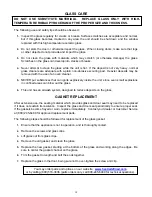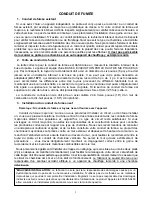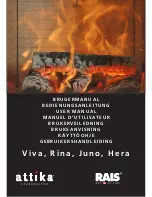
30
PLEASE
NOTE:
EPA
INFORMATION
The
following
additions
to
your
owner’s
manual
will
enable
you
to
achieve
optimal
emissions
performance
from
your
stove.
Important
safety
tips
are
also
included.
‐
Proper
Installation
–
Please
refer
to
the
Installation
section
of
your
owner’s
manual
and
follow
the
guidelines
listed
therein
for
safety
and
for
optimal
emissions
performance.
Additional
information:
Venting
Introduction:
Draft:
Draft
is
the
force
which
moves
air
from
the
appliance
up
through
the
chimney.
The
amount
of
draft
in
your
chimney
depends
on
the
length
of
the
chimney,
local
geography,
nearby
obstructions
and
other
factors.
Too
much
draft
may
cause
excessive
temperatures
in
the
appliance
and
may
damage
the
catalytic
combustor
.
Inadequate
draft
may
cause
backpuffing
into
the
room
and
‘plugging’
of
the
chimney
or
the
catalyst
.
Inadequate
draft
will
cause
the
appliance
to
leak
smoke
into
the
room
through
appliance
and
chimney
connector
joints.
An
uncontrollable
burn
or
excessive
temperature
indicates
excessive
draft.
Please
be
mindful
of
installation
location:
Inversion
and
other
air
quality
issues
can
arise
in
valleys
or
if
unit
is
installed
close
to
neighboring
homes.
This
wood
stove
operates
on
a
natural
draft
system,
in
which
the
chimney
system
pulls
air
through
the
stove.
This
unit
must
be
installed
in
accordance
with
the
following
detailed
descriptions
of
venting
techniques;
not
installing
the
stove
in
accordance
with
the
details
listed
here
can
result
in
poor
stove
performance,
property
damage,
bodily
injury
or
death.
Avoid
make
‐
shift
compromises
when
installing
the
venting
system.
England’s
Stove
Works
is
not
responsible
for
any
damage
incurred
due
to
a
poor
or
unsafe
installation.
Be
certain
that
all
aspects
of
the
venting
system
are
installed
to
the
venting
manufacturer’s
instructions,
particularly
the
required
clearances
to
combustibles.
Also,
be
certain
to
use
an
attic
radiation
shield
to
prevent
insulation
from
contacting
a
chimney
which
passes
through
an
attic.
The
chimney
system
is
the
“engine”
which
drives
a
wood
stove,
so
it
is
imperative
for
proper
unit
function
that
the
venting
system
be
installed
exactly
as
described
in
the
following
section.
If
questions
arise
pertaining
to
the
safe
installation
of
the
stove,
our
Technical
Support
line
(800
‐
245
‐
6489)
is
available.
Contact
your
local
code
official
to
be
certain
your
installation
meets
local
and
national
fire
codes,
and
if
you’re
uncertain
about
how
to
safely
install
the
stove,
we
strongly
recommend
contacting
a
local
NFI
certified
installer
to
perform
the
installation.
Venting
Guidelines:
ALWAYS
install
vent
pipe
in
strict
adherence
to
the
instructions
and
clearances
included
with
your
venting
system.
•
DO
NOT
connect
this
wood
stove
to
a
chimney
flue
which
also
serves
another
appliance.
•
DO
NOT
install
a
flue
pipe
damper
or
any
other
restrictive
device
in
the
exhaust
venting
system
of
this
unit.
•
USE
an
approved
wall
thimble
when
passing
through
a
wall
and
a
ceiling
support/fire
stop
when
passing
through
a
ceiling.
WOOD -
Meets
the
2015
U.S.
Environmental
Protection
Agency’s
crib
wood
emission
limits
for
wood
heaters
sold
after
May
15,
2015
Содержание 13-NCC
Страница 20: ...20 Placement of Stainless Steel Burner Tubes for all 13 NCMH 50 SNC13MH and 50 TNC13MH stove models ...
Страница 29: ...29 ...
Страница 57: ...23 ...
Страница 60: ......
















































